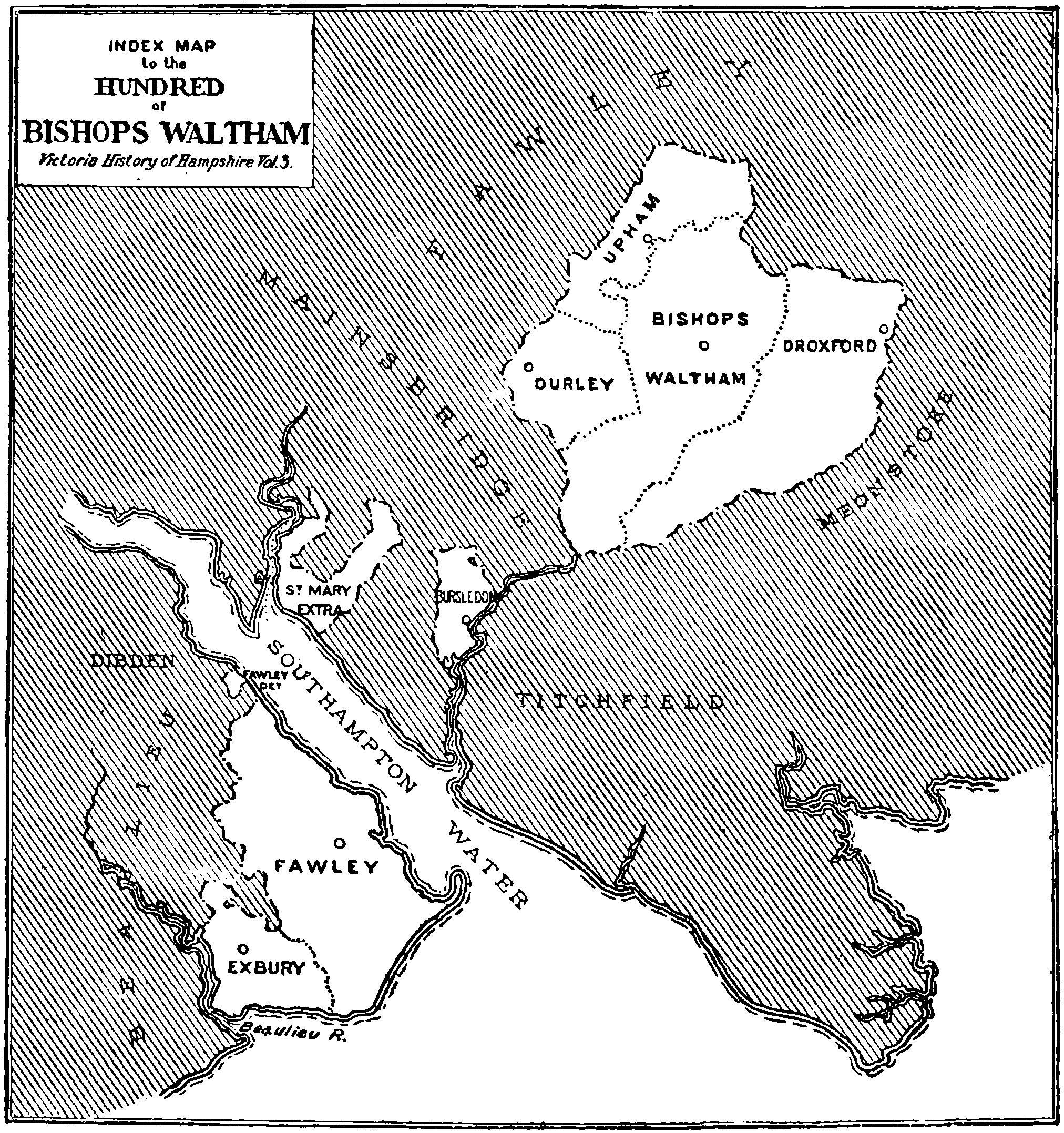A History of the County of Hampshire: Volume 3. Originally published by Victoria County History, London, 1908.
This free content was digitised by double rekeying. All rights reserved.
'The hundred of Bishop's Waltham: Introduction', in A History of the County of Hampshire: Volume 3, ed. William Page (London, 1908), British History Online https://prod.british-history.ac.uk/vch/hants/vol3/pp274-275 [accessed 7 February 2025].
'The hundred of Bishop's Waltham: Introduction', in A History of the County of Hampshire: Volume 3. Edited by William Page (London, 1908), British History Online, accessed February 7, 2025, https://prod.british-history.ac.uk/vch/hants/vol3/pp274-275.
"The hundred of Bishop's Waltham: Introduction". A History of the County of Hampshire: Volume 3. Ed. William Page (London, 1908), British History Online. Web. 7 February 2025. https://prod.british-history.ac.uk/vch/hants/vol3/pp274-275.
THE HUNDRED OF BISHOP'S WALTHAM
CONTAINING THE PARISHES (fn. 1) OF
| BISHOP'S WALTHAM | DURLEY | ST. MARY EXTRA, otherwise WESTON |
| BURSLEDON | EXBURY (with LEPE) | |
| DROXFORD | FAWLEY | UPHAM |
The hundred of Waltham was at first identical with the manor of Waltham, which consisted of 38 hides acquired in 904 by the bishop of Winchester from King Edward the Elder in exchange for 40 hides at Portchester. (fn. 2) This grant was afterwards confirmed by King Edgar, who describes the land as consisting of 28 cassae. (fn. 3)

INDEX MAP to the HUNDRED of BISHOPS WALTHAM
There is no mention of the hundred as such until the Domesday Survey, which gives Waltham as the only place within it. Waltham was then held by the bishop of Winchester, and was reduced to 30 hides. (fn. 4) Of the other parishes now in Bishop's Waltham Hundred which are mentioned in Domesday, Droxford was in Droxford Hundred; (fn. 5) Fawley, with the manors of Langley, Hardley, Stone, and Stanswood, was in Redbridge Hundred; (fn. 6) and Woolston (in St. Mary Extra) was in Mainsbridge Hundred. (fn. 7) There is no mention of Exbury in Domesday, but 'Gatingeorde' in Redbridge Hundred has been conjecturally identified with Gatewood in the parish of Exbury. (fn. 8)
A court held at Bishop's Waltham in 1236 had jurisdiction over the following tithings: Durley, Bursledon, Mincingfield, Curdridge, 'How' (presumably West Hoe), Wintershill, Upham, Woodcott, and Ashton; (fn. 9) showing that at this date Waltham manor (still co-extensive with the hundred) included what were later the separate parishes of Upham, Durley, Bursledon, and Bishop's Waltham.
An attempt to enlarge the jurisdiction of Bishop's Waltham Hundred was made in 1284, when it was granted to the bishop that the men of his manors of Bitterne, Fawley, Ower, and Stoneham should henceforth attend the hundred court of Waltham instead of that of Sweyneston in the Isle of Wight. (fn. 10) The change was probably proposed with a view to convenience, but apparently even Bishop's Waltham was found to be too distant, for the inhabitants of the above places invariably attended a separate court at Bitterne. (fn. 11) Though Fawley is duly entered as a part of Bishop's Waltham Hundred in 1316, (fn. 12) there is no evidence that the inhabitants of Fawley ever actually attended the hundred court at Waltham.
The entries of 1316 also show that Holbury, Hardley, Butsash, and Langley (all in Fawley parish) were attached to the New Forest Hundred at this date, as were also Exbury and Leap. (fn. 13) Droxford, however, had become a part of Bishop's Waltham Hundred, (fn. 14) the incorporation being exemplified on a court roll of the year 1337, (fn. 15) on which the tithings of Droxford, Swanmore, Shedfield, and Midlington are added to those already noticed in the year 1236.
In 1551 Bishop Poynet surrendered the hundred of Bishop's Waltham to Paulet the Lord Treasurer. (fn. 16) It was granted by the crown the following month to the earl of Wiltshire, (fn. 17) and restored to the bishopric by Queen Mary in 1557. (fn. 18)
The court rolls continue through the sixteenth, seventeenth, and eighteenth centuries, the parishes practically included in the jurisdiction of the hundred being apparently Bishop's Waltham, Upham, Durley, Bursledon, and Droxford. (fn. 19) The parish of St. Mary Extra never appears on the Waltham court rolls, the reason being that practically all the land was included in the manor of Bitterne. Fawley and Exbury are also absent, but some time between 1785 (the last court roll extant) (fn. 20) and 1831 all these three outlying parishes must have been formally incorporated into the hundred of Bishop's Waltham.
